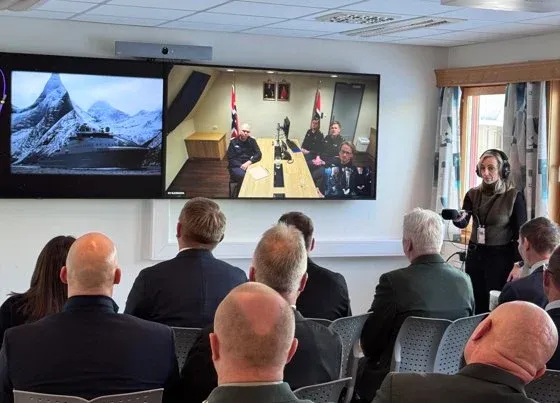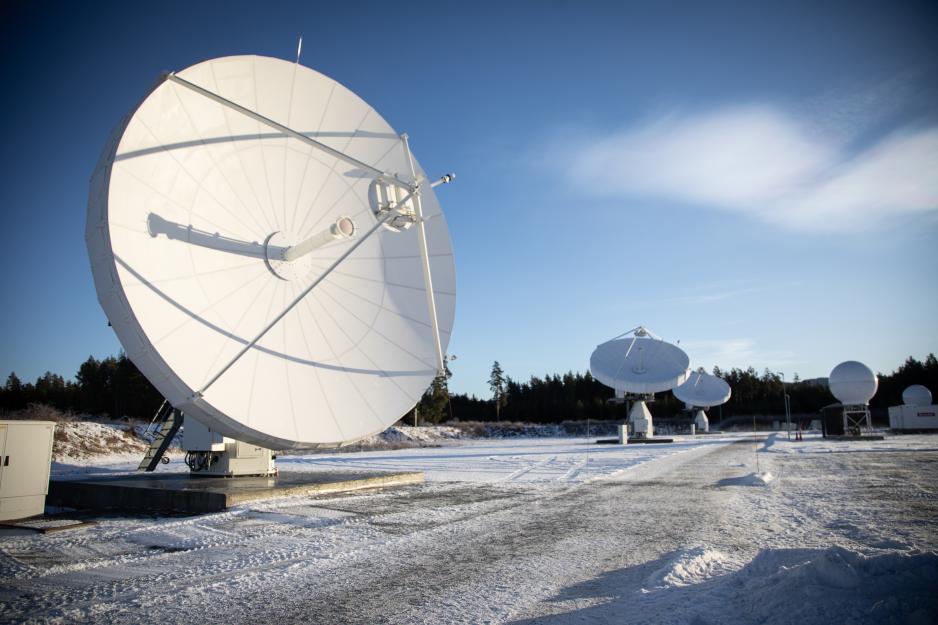The Norwegian Armed Forces With Full Broadband Coverage in the Arctic

Norway's largest satellite program, the Arctic Satellite Broadband Mission, now provide continuous connectivity for the Norwegian Armed Forces on northern operations. This was marked at Eggemoen satellite station in Southern Norway by the Chief of the Norwegian Armed Forces Cyber Defense, Brigadier General Halvor Johansen, Norway’s Minister of Defense Bjørn Arild Gram and Space Norway's Executive Vice President Dag Stølan. (Photo: Anette Ask/the Norwegian Armed Forces)
Norway’s Arctic broadband satellites are now operational and put into use by the Norwegian Armed Forces. "This enables us to exercise effective command and control in all types of operations up to the North Pole," says the Chief of the Norwegian Cyber Defense.
Before Christmas, the activation of the Norwegian Armed Forces' satellite-based network coverage in the Arctic was marked both symbolically and in practice.
Norway’s MoD Bjørn Arild Gram, flanked by leaders in the Norwegian Cyber Defense and Space Norway, cut the ribbon in front of new ground antennas at the Norwegian Armed Forces' satellite station at Eggemoen – and conducted a first video call with the new capacity to the Coast Guard vessel KV Bjørnøya operating in Arctic waters.
"For the first time, we have full control over strategically important communication services in an area lacking broadband until now. This provides us with better situational awareness in the north, which is important to ensure regional stability and predictability. It helps safeguard Norway," says Gram (Center).
More specifically, the Norwegian Armed Forces Cyber Defense has now taken over the control of payloads with military X band, carried by two new Arctic broadband satellites.
The Arctic Satellite Broadband Mission (ASBM) is led by the Norwegian state-owned company Space Norway, with the Armed Forces as one of its customers.
The satellites were launched this summer by Space X at Vanderberg Space Force Base, USA, and formally handed over to Space Norway in October.

The video call with the crew of KV Bjørnøya on operation in the north from Eggemoen in the south through the new Arctic satellite broadband. (Photo: Emil Bremnes/the Norwegian Ministry of Defense)
Milestone
"Broadband in the Arctic will have great significance for our communication capabilities. This enables us to exercise effective command and control in all types of operation all the way up to the North Pole," says the Chief of the Norwegian Armed Forces Cyber Defense, Brigadier Halvor Johansen.
"The ASBM program also opens up more opportunities for cooperation across defense branches and with our allies. This is an important milestone for Norway's defense capabilities," he continues.
Johansen also expresses gratitude for the good cooperation with the other actors in the program.
"We are both proud and glad to deliver perfectly functioning payloads with antennas and associated ground systems for the Norwegian Armed Forces. Delivering this capacity to the Armed Forces is the most important rationale for the ASBM program, which is Norway's largest space program ever," says Kjell-Ove Orderud Skare, Program Director for ASBM in Space Norway.

Ground antennas at Eggemoen communicating with the ASBM satellites. The two move in a highly elliptical orbit where they slowly hover at high altitude over the North Pole and take a rather quick, tight turn past the South Pole. They provide continuous broadband coverage north of 65 degrees latitude by overlapping each other. (Photo: Anette Ask/the Norwegian Armed Forces)
For military and civilian use
The two Arctic broadband satellites are operated from Tromsø, Northern Norway, by a composite team from Space Norway's subsidiaries, HEOSAT and Kongsberg Satellite Services.
The customers, including the US Space Force, the commercial broadband supplier Viasat, and the EU Commission, operate the payloads themselves.
Space Norway also delivered the capacities to them this fall.
- The US Space Force controls payloads with a military frequency band (Enhanced Polar System—Recapitalization) from a ground station in Alaska.
- Viasat manages payloads with a civil frequency band (Ka-band) from its technical center in London.
- The EU Commission's Department for Defense Industry and Space in Brüssels receives data from its payload NORM – a Norwegian-led monitor that maps the radiation environment to benefit the design of future Galileo navigational satellites.
Viasat expects to launch its Arctic broadband service in 2025, according to Space Norway. Then, civilian users in the Arctic – such as aircraft, fishing boats, research vessels, and cruise ships – will also benefit from the new coverage.
More about the satellite program
• Space Norway – owned by the Norwegian Ministry of Trade, Industry, and Fisheries – started the work with the Arctic Satellite Broadband Mission in 2014.
• First, the company signed contracts with the Norwegian Armed Forces and the satellite supplier Inmarsat (now part of Viasat).
• Later, the US Armed Forces and the EU Commission also expressed their interest, based on the need for broadband coverage in Alaska and mapping of the radiation environment with an aim to design future satellites, respectively.
• The ASBM program was decided to be carried out in 2019, and construction of the satellites began at the factory of the defense industry group Northrop Grumman in Virginia, USA.
• The two satellites measure 3x3x4 meters, have a wingspan of 27 meters, and weigh around 2 tons. The launch took place, as mentioned, under the auspices of the US space transport company SpaceX.
• The project has an investment framework of about USD 450 million, and the satellites’ capacity has been sold out for their entire lifespan.






